From The CRPG Addict
Paladin’s Legacy
United States
Independently developed; published by Sundog Systems
Released 1989 for TRS-80 Color Computer
Date Started: 12 December 2018
Date Ended: 16 December 2018
Total Hours: 9
Difficulty: Moderate (3/5)
Final Rating: (to come later)
Ranking at Time of Posting: (to come later)
As we’ve seen before, the TRS-80/Tandy Color Computer was an under-served platform for both RPGs and games in general. To the extent that they marketed it at all, Tandy and Radio Shack marketed it as a primarily business platform. It is unique in that almost every RPG that existed for it existed
solely for it; it received no ports of popular titles like
Wizardry or
Ultima. If you were a Color Computer owner and you liked RPGs, you suffered a lonely, frustrating existence. Only half a dozen RPGs were available to you, and half of them were
Ultima clones.
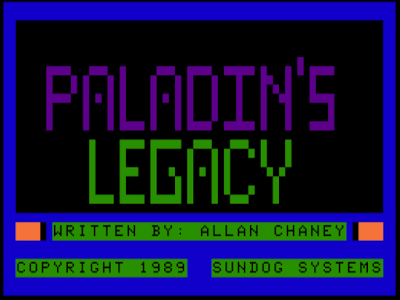 |
| Stretching out the introduction gives me space to show both title screens. |
Paladin’s Legacy is one of those Ultima clones, but it’s a relatively competent game that feels like it was programmed by an adult. It avoids the mistakes common to many of its contemporaries (1987’s Gates of Delirium comes to mind), tells a decent story, and doesn’t try to be epic.
The story takes place in the land of Tarinth. The human, dwarf, and elf populations historically left each other alone, but a few hundred years ago, the land came under attack by a mysterious flood of monsters. When everything seemed bleakest, a hero–the titular paladin–appeared and drove back the hordes with his enchanted armor and blade and his mastery of the five schools of magic. The paladin died after a long, mortal life, and he left his equipment in the hands of a mysterious being known as the “keeper.”
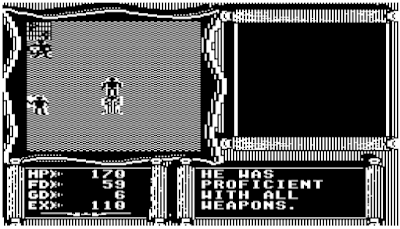 |
| A noblewoman relates some history of the paladin. |
In the wake of the attack, the three races unified under a central government with councilors and an elected king. Five cities were established to study the different schools of magic that the paladin had wielded. All was at peace. Flash forward to today, when the monsters suddenly appeared again, invaded the castle during a council session, and kidnapped the king. It’s time for a new hero to arise and so forth.
It took me a while to get it running, and like most of the time I try to play a game on one of the rarer platforms, we have Adamantyr to thank for this entry. But even with his help, I couldn’t get the color settings right. When you first launch the game, it asks whether you have an RGB monitor, and then gives you a color or black-and-white version of the game depending on your answer. All of the color settings looked horrendous to me, so I played the game in black and white. I’ve seen screenshots in which the color looks better, so I don’t know what I had wrong. I apologize for the predominantly black-and-white screenshots below.
 |
| The beginning of the game in RGB mode. It makes me want to kill indiscriminately. |
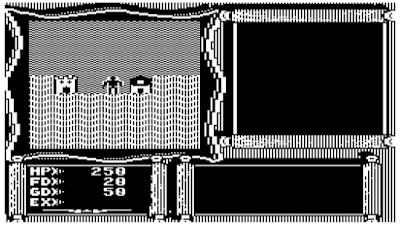 |
| The same shot in black-and-white. |
Character creation has you allocate 60 points to four attributes: strength, dexterity, wisdom, and intelligence. You can assign a maximum of 20 and a minimum of 10. The developer remarks on his web site (more below) that wisdom and intelligence aren’t even used in the game. This is the title’s only major sin, compounded by the fact that you can increase these values in the game, so an unknowing player may actually grind these useless attributes.
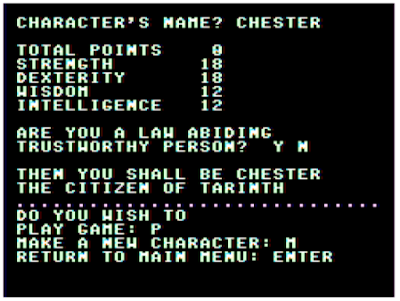 |
| Character creation. |
The last question asks whether you’re a law-abiding person. Say yes, and you start as “Chester the Citizen.” Say no and you start as “Chester the Thief.” I’m not sure what difference this makes in gameplay. I tried both options and didn’t notice any changes in dialogue or anything.
Gameplay takes place on an 80 x 80 map that I actually mapped, for no really good reason except that I was having trouble counting the squares otherwise. The MESS emulator (or the game) was inconsistent with my inputs, sometimes reading a single arrow press as two and sometimes not reading it at all. The land ultimately has nine cities, a castle, a cathedral, and a dungeon with two entrances. At the beginning of the game, only four cities, the castle, and the cathedral are accessible. Commands are easy to memorize: arrows for movement and obvious keys like (A)ttack, (E)nter, (G)et, and (T)alk for other actions. In an epic example of not reading the manual carefully, I overlooked the (R)estore command and, throughout this experience, rebooted the game from scratch on the occasions I had to reload.
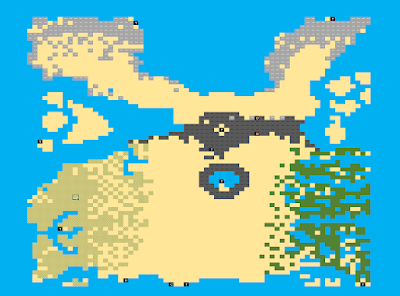 |
| The game world. |
You start with meager resources–250 hit points, 20 gold, and 50 food–but fortunately the beginning of the game isn’t so tough. After you buy an affordable weapon and suit of armor, the monsters that roam the land (e.g., orcs, sprites, jackals) are easily slain, and you just have to occasionally pop into town for more food, or into the cathedral for a healing potion. Things get even easier when you find a fairy in the city of Elm who will heal you for free–if you’re “pure of heart.” A number of things make you impure, including stealing a boat, purchasing thieves’ tools, and perhaps starting as a thief, but this condition is easily curable by donating 10 gold pieces “to the poor” at the cathedral.
 |
| I love how the ankh cross became the all-purpose “religious symbol” of the RPG world. |
In the castle, the queen will level you up every time you achieve 1000 experience points, which takes about 10 minutes of grinding on the surface and less once you start exploring the dungeons. Leveling up increases maximum hit points by 250. Slowly, you amass more gold, buy better items, and improve your ability to survive for longer periods.
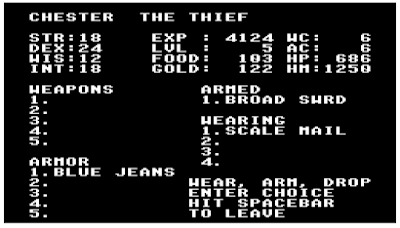 |
| A mid-game character sheet. |
Combat is unfortunately the weakest part of the game. You simply sidle up to a creature and either attack it or wait for it to attack you. You then pass the rounds by mashing the SPACE bar, watching as you trade damage. There’s no way to escape, no tactics, and no spells. It all comes down to your attributes and equipment.
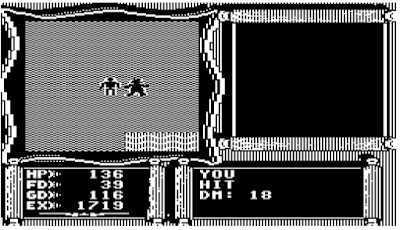 |
| Battling an orc. |
Most of the game’s length involves circling the land’s cities and getting appropriate items and clues. The thieves’ guild sells three items that are vital to this process: lock picks for entering the sealed dungeon, climbing gear for crossing mountains, and snow boots for crossing snowy mountains without sliding off in a random direction. With these items, you can cross the mountains in the northern part of the map and visit the remaining cities. A boat is necessary to reach one island town; you can buy one for 1,000 gold pieces or steal one in Tabor Slyth if you find a hidden passage. Late in the game, finding a magic carpet in the dungeon makes travel–which wasn’t hard in the first place–a cinch.
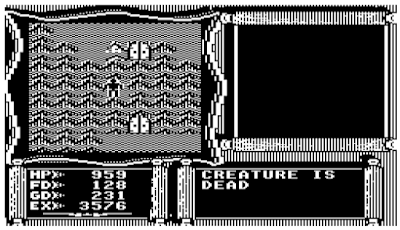 |
| Climbing gear lets me through the mountains. Note the two entrances to the dungeon. |
Each city contains around 6-12 NPCs who impart valuable information. The NPCs are more verbose than their counterparts in, say, Ultima II or Ultima III, but there’s no complex interaction. At best, you occasionally get a yes or no question.
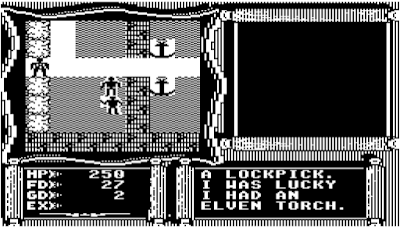 |
| I get a clue from a thief. |
The cities and major encounters are:
- New Tear (a possible homage to the Wheel of Time series?), the human city. It has a weapon shop, armor shop, and food shop. An NPC named Bob tells you that trade has been stifled by all the roaming monsters. A thief named Tamara relates how she lost a magical elven torch in the dungeon. John, a sailor, relates finding the city of Optus on a western island.
- Castle Tarinth. The guards and councilors are abuzz about the recent attacks. Heckel the Historian says that the same type of attack happened 200 years ago, but the paladin was there to defeat the evil creatures. The anguished queen offers to help any hero who will agree to search for her husband.
 |
The unnamed queen takes Lord British’s role from the Ultima games.
|
- Elm, the city of elves. Like everyone else, they’re upset about the king’s kidnapping, saying that he was the only force uniting the lands. Someone saw the king being dragged towards the old dwarven mine.
 |
| The selection at Elm’s weapon shop. |
- Gindle Frey, city of dwarves. They operated a mine in the mountains until a recent explosion brought evil creatures boiling out of the earth. The mine has six levels, the first four of which the dwarves call the Great Hall, Lake Town, the Maze, and the Treasure Room.
- Tabor Slyth, the city of thieves. It lies in swamps to the southeast. It exists to sell you crucial items at the guild, and various NPCs give hints as to why they’re necessary.
- Pawn. Locals call it the “city of perfection.” It is nestled in the mountains and reachable only with climbing gear. The inhabitants study the laws of magic. A Master Gulin created a teleportation ring but it was stolen by a thief. Master Reed gives the player the Scroll of Magic if he agrees to seek the king.
- Mendoris, city of the Eternal Flame, also surrounded by mountains. The inhabitants study wizardry, which deals with the control of demonic beings. The player learns that he can control demons if he learns their names. A quick trial (involving stepping into flames) brings the player to Master Veltic, who offers the Scroll of Wizardry and gives the name of the evil demon threatening the lands as ASHTALAM.
 |
| A key piece of intelligence. |
- Tardis. The city is on the northeast coast, surrounded by snowy mountains. The player needs snow boots or a boat to reach it. The inhabitants study thaumaturgy and the manipulation of gravitational fields. The player learns of the magic carpet and receives the Scroll of Thaumaturgy.
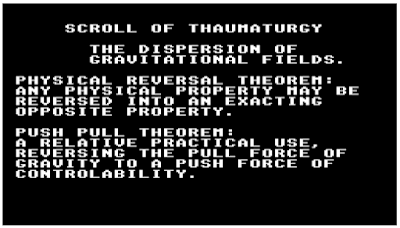 |
| Each of the scrolls can be read for hints about the endgame. You don’t really need them, however. |
- Amber. On the northwest coast, also accessible only with snow boots or a boat. The citizens study alchemy and tell of a potion called Aqua Regia, which dissolves any metal. The player receives the Scroll of Alchemy.
- Optus, the island city, where the citizens study the “maxim of inner sight.” The player receives the Scroll of Sorcery and learns of the Sorcerer’s Eye, an artifact that allows for seeing great distances.
Each of the three “race” towns (New Tear, Elm, and Gindle Frey) sells special weapons and armor fashioned in race-specific ways. In New Tear, the humans are proud of their inventions of polymers; in Elm, the elves talk of wood from the rare Lormil tree; and in Gindle Frey, the dwarves fashion items from Galvamite ore. Ultimately, I think the best items are Synthetic armor from New Tear and either the Lormil Bow or the Galvamite Axe, but in all cases the items costs thousands of gold pieces and it takes several trips to the dungeon to finance an entire set. I should also mention that you can wear four pieces of armor: the main suit, a helm, gauntlets, and a shield, each piece found in different towns.
 |
| A dwarf brags about his materials. |
There is only one dungeon in the game–the aforementioned dwarven mines–accessible from either side of the central mountains with some lockpicks. The dungeon has creatures much harder than the surface, including balrons, pinchers, vampires, and stalkers, some of which can knock away 1,000 hit points in a single battle even with the best equipment. Carrying a stock of healing potions from the cathedral is vital when exploring the dungeon.
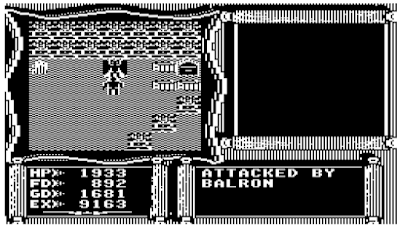 |
| These guys are particularly hard. |
The game gets a lot easier once you grow tough enough to penetrate to the dungeon’s fourth level, where you find copious treasure chests. Chests can contain, gold, food, attribute increases, and artifact items–including the magic carpet, the elven torch (which allows you to see in a greater radius), the teleportation ring (which allows you to move two squares in any direction), the Aqua Regia, the Sorcerer’s Eye, and an invisibility cloak. Chests (and enemies) respawn when you leave a level and return, so you can grind gold and attributes to epic levels.
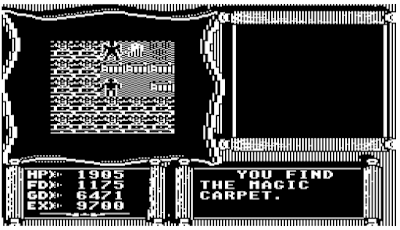 |
| Finding the magic carpet while a “stalker” waits to attack. |
The endgame commences on Level 5 of the dungeon. I was able to win, just barely, at character Level 15, with strength and dexterity boosted to about 60 and all the best equipment. There’s a water level where you sail a boat around and teleport through a wall (using the ring) to get the Aqua Regia. You then sail into Level 6, where there’s a maze. The Sorcerer’s Eye helps.
 |
| The levels are small enough that the Eye isn’t strictly necessary, but it helps. |
At the end of the maze is a battle with balrons and dragons that taxed my healing potion reserves. Once they’re dead, an iron golem refuses to let you enter a building. The Aqua Regia takes care of him.
 |
| If Gandalf had carried acid at this moment, the entire film series would have gone differently. |
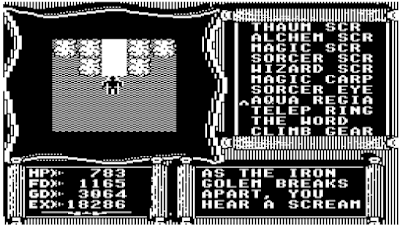 |
| Wow, I thought golems were non-sentient. I feel bad now. |
On the other side of the golem is a maze with more balrons and dragons. At the end, you meet the “keeper,” who will allow you to pass through the gate to the Nether Region if you have the five magical scrolls. He warns that you can’t take any of your items (this is a good time to suck down the rest of your healing potions), but he gives you the paladin’s armor and sword to take with you.
 |
| Yeah, I’d better reload and drink some healing potions first. |
On the other side of the gate is a maze of fire, where you take damage if you step off the path and into the flames–which I did constantly thanks to the key lag problems I discussed above.
 |
| In retrospect, it was probably a bad idea to try to save there. |
Eventually, you find the entrance to a “city.”
 |
| Classic overlord smack talk. |
As you explore the small city, Ashtalam’s voice taunts you as balrons and dragons attack. It occurred to me that the invisibility cloak might have been useful at some point, but I never thought to put it on. Eventually, you make your way to Ashtalam’s chambers. He tells you that he’s killed the king and says he’s going to do the same to you.
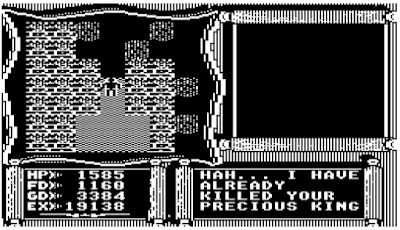 |
| This was a blow. |
You have to push your way up to him as he blasts you with energy, and once you’re adjacent to him, you use “The Word” to say his name.
 |
| Chinese subtitle: “Do not want!” (Did I already make that joke somewhere? I feel like I did.) |
The endgame text is such:
Thanks to you, the demon Ashtalam is no more. He presently resides in the eternal abyss. He was sentenced by higher authorities to spend several lifetimes in torment. His losses on this campaign were outrageous, and therefore much payment is due. Because of your great deeds, you have been chosen by the people to be the king and protector of Tarinth. The queen, though burdened with sorrow from the loss of her husband, has agreed to tutor you in the laws of the land. Once again the 3 nations are united. The people will undoubtedly prosper from new avenues of trade. You are the paladin king!
You’re teleported back to the castle, and you get to wander the land with a fancy new icon. The queen has some new dialogue, but unfortunately no one else seems to.
 |
| My heroic new icon talks to the queen. |
Paladin’s Legacy earns a 31 in the GIMLET. The back story is solid and well-referenced throughout the game (4), it makes good use of Ultima-style NPCs (4), and it has a tight and continually-rewarding economy (5). It also does well in the “gameplay” category (5) for its moderate length, medium difficulty, and quasi-nonlinearity. The keyboard-based interface is easy to use (any game that maps each action to a separate key will always get a high score here), but the graphics and sound are only just adequate (3). Combat is the weakest category (1), particularly since the game has no magic system, and everything else is in the 2s and 3s.
 |
| Thankfully, approaching the castle isn’t this hard in-game. |
Paladin’s Legacy was written by Allan Chaney, who maintains
a site devoted to the game. Although I said that the game “feels like it was programmed by an adult,” Chaney was in fact in high school when he began writing the game–then called
Quest for the King of Zandor–in BASIC. A classmate helped him convert it to assembly code. Chaney shopped the game to several publishers before Sundog Systems–a Pittsburgh, Pennsylvania-based company operating out of a residential address–agreed to sell it. Chaney reports that sales were good “for about 4 months and then the Color Computer market collapsed and sales stopped.”
 |
| Sundog had a small catalog of games, but no other RPGs. |
Chaney cites Ultima and Richard Garriott as his primary inspirations, although some of the navigation obstacles make me wonder if he also played Questron. He notes he was “horrified to find that there were no games like Ultima for the Tandy Color Computer,” and that he probably wouldn’t have bothered making Paladin’s Legacy if Ultima had ever received a Color Computer port.
I left a message on Chaney’s site, and I hope it might draw him here for some further comments. Otherwise, we move on to another Ultima clone for the Color Computer, The Seventh Link. It’s worth noting that with the completion of this game, all games that appear at the bottom of my “upcoming” list from now on will be from the same list. (Yes, I still have to go back and clean up some pre-1992 discoveries, but we’ll talk about that when I get finished with Zerg.) I’m suddenly feeling all kinds of momentum.
Original URL: http://crpgaddict.blogspot.com/2018/12/game-311-paladins-legacy-1989.html






























